Misalignment is one of the most common pump maintenance issues. It’s important to prevent this by capitalizing on the right technology to detect and respond to it earlier. In many cases, laser pump alignment is the ideal solution.
As its name suggests, this practice uses lasers to detect misalignment. Whenever a laser on one end of a shaft no longer hits the receiver on the other end, it indicates the component has fallen out of alignment. The equipment can then automatically alert you of the issue.
Benefits of Laser Pump Alignment
This tech-centric approach to pump maintenance has several key advantages. Most notably, it’s more reliable than conventional alternatives. Lasers travel in such a straight line that they can remain focused to the moon and back — more than enough for accurately measuring components a few inches apart. They also minimize sagging and excess weight, as they don’t require brackets or heavy components.
Laser alignment also enables immediate alerts as soon as conditions are no longer acceptable. Waiting for more obvious signs to show can lead to significant losses. Pressure only has to drop by 2 psi to impact costs and efficiency, so catching things quickly is important. You can do that through laser measurement, which doesn’t require manual reading or inspections.
Removing the need to interpret results also eliminates human error from the equation. Similarly, lasers need minimal setup and calibration, reducing the risk of mistakes. Consequently, you can trust their results even if you lack experience using this equipment.
Making the Most of Laser Pump Alignment
These benefits are too significant to ignore. Like with any tool, though, laser pump alignment is only as effective as how you use it.
While laser equipment requires less calibration than conventional methods, ensuring it works before use is still important. Follow the OEM’s instructions for calibration, then test their response by intentionally misaligning them to see if they register it appropriately.
You may also need to define acceptable tolerances for your laser pump alignment system. Refer to any applicable regulatory standards or, if no regulations apply, OEM recommendations for these figures. Adjust the laser system as necessary to accommodate these tolerances.
How you use these laser measurements can impact the results. One of the most effective options is condition-based maintenance, where you inspect and repair pumps after receiving a misalignment alert. However, you could also use laser data to enable predictive maintenance, where AI models predict future maintenance needs.
Predictive maintenance offers the most uptime, but only under the right conditions. Some facilities have experienced more downtime and costs thanks to high false positive rates. Condition-based upkeep may not have as much long-term potential, but it’s easier to get right. Consequently, predictive maintenance is ideal for highly sensitive applications, while condition-based monitoring is best for most normal operations.
Technology Unlocks New Levels of Reliability
Misalignment is common but potentially damaging. Your ongoing equipment care must be as precise and reliable as possible to minimize problems and protect mission-critical operations. Laser pump alignment offers that precision and reliability.
These systems may cost more upfront than conventional methods but deliver better results and long-term cost savings.





Comments